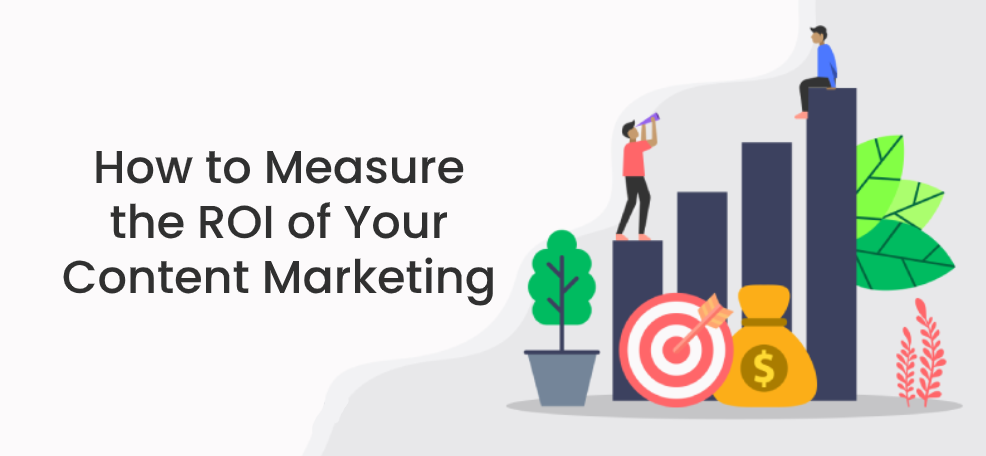You can invest loads of money into content marketing, but it can also be one of the hardest things when it comes to tracking your return on investment (ROI). But it’s important that you figure this out so that you know you’re not just chucking you money away on useless content or so that you can see which areas of your content marketing work, which need to be improved upon and which you should just stop altogether.
ROI is about comparing the resources (time and money) spent on something with the results it brings. Often this is the financial gain (the profit) you make when you take away the money you originally invested, this is typically understood as the ROI. But in terms of content marketing, other metrics can and should be used to measure the return, such as the number of followers gained on social media, page rankings, or the quality of leads being produced from online content.
Because of this, the ROI can’t be determined without first understanding how your content relates to your overall business goals. For example, if your goal is to increase your social media presence and so you’ve been investing in content for social media, you might want to use metrics such as followers gained to work out your ROI.
In this guide, we’re going to take a closer look at how you can understand and measure the ROI of your content marketing, so you can find out what really works for your business.
Deciding what to track

Content marketing is not just about creating awesome content for your brand (though that is a huge part of it), it’s also about ensuring this content achieves the desired results. In order to understand your return on investment, you need to know what it is you’re tracking. As previously stated, often ROI is understood as being about financial gain, but this doesn’t always have to be the case.
So before you begin any new content marketing campaigns, you must first understand who you are actually targeting what you’re aiming to achieve so you can align your results with your overall goals. This will help you to determine the ROI. Below are some suggestions for important metrics you may use when tracking your content marketing:
- Social media engagement – be that followers, comments, likes, or shares
- Website traffic and engagement
- Email open rate/replies – email outreach is still one of the most effective forms of marketing and so it’s important to really nail this aspect of the process and ensure that your email deliverability has been fully optimized to improve your chances
- SEO success – looking at whether your pages are ranking well on Google and for the right keywords
- Newsletter sign-ups
- Sales – from adverts, newsletters, social media posts, etc.
- Quality of leads – working with the sales team, you may be able to identify how potential customers and clients are being directed to your goods or services and whether this leads to a sale
What you choose to track is up to you and will ultimately depend on what you want to achieve from your content. Just be sure to have a good idea of the metrics you’re using to calculate the ROI of your content marketing before you begin. This will better help you to give feedback to the team and measure your success.
Collecting and analyzing your data

Next up, you need to collect and analyze the data from your content. Again, there are several ways to do this depending on what you’re measuring. You might take the simple approach and look at how many sales were made as a result of a specific piece of content. Tracking links and visits to your website through Google Analytics can be very useful for this. Alternatively, you might want to monitor your web traffic or social media engagement over a set period of time, for example over a week or month. There are several platforms you can use to do this including GA, Hootsuite, Sprout, and BuzzSumo.
Last but not least, you might want to use an SEO service provider or SEO platform to check how you’re doing with your rankings. Before you start to invest in your content it pays to put together a database listing where you currently rank and for what keywords. This will help you to monitor your progress.
Once you’ve collected your data through your chosen method, you can begin analyzing. Most tools and platforms will come with filtering options to help you do this.
Calculating and reporting the ROI

In order to be really specific with reporting your ROI, it pays to come up with your own formula where you can. As a general rule, the basic formula for calculating ROI is:
(Return-Investment)/Investment x 100 = percentage ROI
But if you’ve chosen to use a different metric, there is still a way you can create the perfect formula to give you a percentage. You just need to do a little bit of thinking and rearranging of the basic formula. Below are some examples of how you can calculate these percentages to help get you started:
Measuring sales resulting from a particular advert:
Formula: Number of sales/number of click-throughs on advert x 100
Example: 1,000 sales/10,000 click-throughs x 100 = 10% ROI
Measuring leads generated by a blog article:
Formula: Number of leads collected/views to blog post x 100
Example: 25 leads/1,000 views x 100 = 2.5% ROI
Measuring an increase in social media followers:
Formula: New followers/total followers x 100
Example: 1,000 new followers/13,000 total followers x 100 = 7.6% ROI
Of course, you don’t have to do this but it can be helpful if you have to relay your findings to your manager or to other senior members of the team. Alternatively, you could keep it simple by collecting your data and deciding whether the money you’re investing in helping you to achieve the desired results and therefore whether it’s worth it. An example of this could be:
Goal: to increase web traffic through Facebook Ads
Budget: £100
Results: Traffic up 23% on the previous month
ROI: Positive
Coming up with actionable steps

Finally, once you have a better understanding of your ROI based on your content marketing, you can begin to put some actionable steps in place for the future. If you’re not seeing the results you want, you might need to re-think your campaigns or ramp up your content efforts. In any case, use your ROI statistics and data analysis to decide what’s working and to set specific, targeted goals. This can help you to take your content marketing and your business to the next level!
About the author:
Natashia Larkin
Natashia Larkin is a Content Marketing Specialist at Levity Digital, an SEO agency based in Northern Ireland. With a passion for writing, she knows how important it is to measure the impact of your content marketing strategies and where to make improvements for future campaigns.




